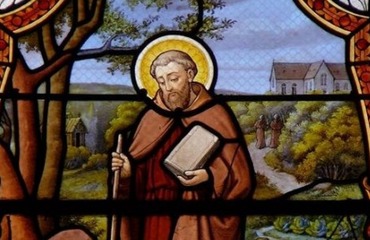-
 August 2, 2025St. Fiacre was an abbot, priest, hermit, and one of the most beloved gardeners in history. Little is known of Fiacre’s youth, except that he was born in Ireland c. 600 and that he spent most of his childhood in a monastery. It is likely that he was born to a noble family, for whom a monastic education of children would have been expected. This was due to the fact that monasteries were known to be centers of higher learning, even in the sixth century. During these years of formation, Fiacre learned a great deal about planting, growing, and harvesting, as well as herbal remedies. Because monasteries attracted visitors from far and wide who often brought their native plants and medicines, Fiacre became keenly interested and skilled in this field of study. His ordination most likely took place before he left this monastery. He was very fond of the mostly silent atmosphere of monastic life and chose to become a hermit. He found some forested land near the Nore River near present-day Kilkenny and settled there in a small hermitage. His reputation for curing numerous ailments, for his abounding garden, and for his holiness began to spread.
August 2, 2025St. Fiacre was an abbot, priest, hermit, and one of the most beloved gardeners in history. Little is known of Fiacre’s youth, except that he was born in Ireland c. 600 and that he spent most of his childhood in a monastery. It is likely that he was born to a noble family, for whom a monastic education of children would have been expected. This was due to the fact that monasteries were known to be centers of higher learning, even in the sixth century. During these years of formation, Fiacre learned a great deal about planting, growing, and harvesting, as well as herbal remedies. Because monasteries attracted visitors from far and wide who often brought their native plants and medicines, Fiacre became keenly interested and skilled in this field of study. His ordination most likely took place before he left this monastery. He was very fond of the mostly silent atmosphere of monastic life and chose to become a hermit. He found some forested land near the Nore River near present-day Kilkenny and settled there in a small hermitage. His reputation for curing numerous ailments, for his abounding garden, and for his holiness began to spread.
SEEKING SOLITUDE
In time, the large number of people who came to Fiacre made it impossible for him to have the silent time for prayer that he craved, so he abandoned the hermitage. In 628, he arrived at Meaux, France, to the east of Paris. There, the Bishop [St.] Faro, who had been the recipient of kindness from an Irish missionary, [St.] Columbanus, received Fiacre and gave him some land for a hermitage. The land was in a forested area at Breuil near the Marne River. This wild area had previously been a gathering place for witchery and other pagan iniquity. There, he built a small dwelling and an oratory in honor of the Virgin Mary. He cleared the land and planted his large garden of fruits, vegetables, herbs, and flowers. In time, he built a hostel to receive travelers.
A REFUGE FOR THOSE IN NEED OF HEALING
He became well known for his charity and his miraculous gift of healing. People in both physical and spiritual distress came to him and, once again, his reputation spread. He would lay his hands on people, and numerous cures were attributed to his prayers. When it became necessary for him to have more land in order to accommodate the numerous pilgrims, he went to Bishop Faro with this request. The bishop granted that he could have as much land as he could plow in one day. Fiacre’s best known miracle occurred when he set out in the morning with his shovel and his prayers, as bushes and even trees toppled over when he merely dragged his shovel across the ground. He ended up clearing enough land for a good-sized monastery. The story of this miracle spread throughout the area, attracting even more visitors seeking food, herbal remedies, and wise counsel from the holy hermit.
Fiacre died August 18, 670 at his monastery at about the age of seventy. His remains were kept at the church at the original hermitage at Breuil, currently known as Saint-Fiacre, Seine-et-Marne. Pilgrims continued to visit his shrine seeking healing through his intercession. When Calvinist Protestantism made inroads into France in the 16th century, Fiacre’s relics were moved for safekeeping to the Cathedral at Meaux, where they remain. The shrine has been visited from some notable people over the years, including St. Vincent de Paul.
PATRON OF GARDENERS
St. Fiacre was likely never able to live the life of solitude, silence, and prayer that he desired, but God had other plans for him. In addition to his countless hours of toil in keeping his large garden and receiving pilgrims, he fasted and spent many nights in prayer. His August 30 feast day was often commemorated in Europe by special floral parades and processions. Being the patron saint of gardeners, a statue of him is often found in gardens, including Cypress Gardens in Florida. He is usually depicted with a shovel or a basket of produce.
